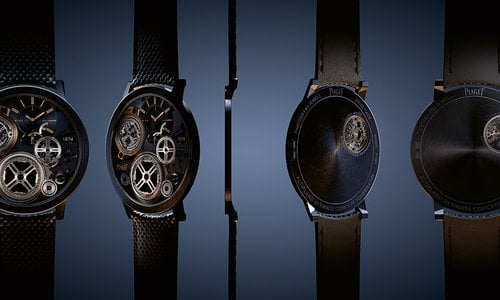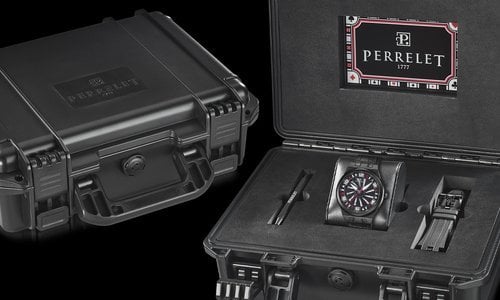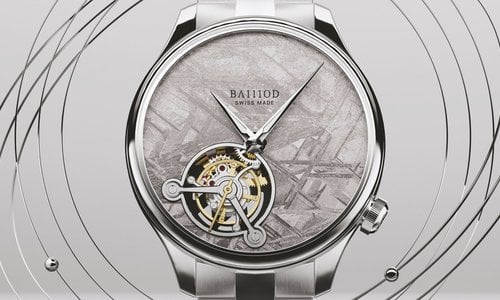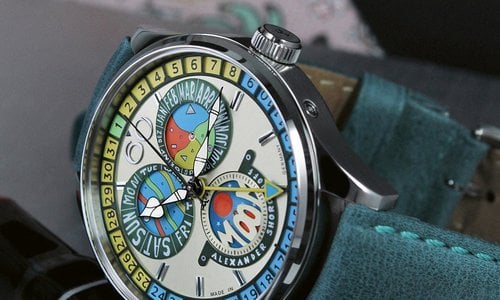This autumn Oris will be introducing a new
original calibre, developed and produced
in-house: the Calibre 112. The movement,
designed specifically with different time
zones in mind, offers incontrovertible
proof that Oris has truly reconnected with
its fundamental values.
In case you didn’t
know, Oris has produced around 285
in-house calibres over its 112-year history,
and was once one of the ten biggest
watch producers in the world.
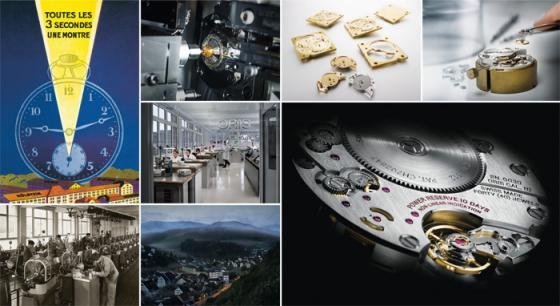
Today, Oris is reconnecting with its illustrious past as a powerhouse of mechanical movement production, offering real watches for real people – in other words: quality, functionality and beauty at ‘democratic’ prices.
Oris was founded in 1904 by Paul Cattin and Georges Christian, two watchmakers from La Chaux-de-Fonds, whose pioneering spirit led them to set up shop in Hölstein, in the Waldenburg valley. Their vision, their objective, was to produce high-quality mechanical watches for mass distribution, using the most advanced production technologies available at the time. They could not have predicted how successful they would become. Barely six years on, in 1910, Oris was already the region’s biggest employer, with more than 300 staff. In 1925 the business was spread across no fewer than six different production sites, including one cutting-edge electroplating plant. At that point in its history, Oris was considered one of the most avant-garde watchmakers of the day. The Second World War brought a temporary reduction in activity, but the 1950s saw Oris rebound, and the business began to grow exponentially. At the head of the company was an industrialist by the name of Oscar Herzog, the brother-in-law of Georges Christian, one of the two founders. Oscar Herzog took the strategy of industrialisation that lay at the root of the company’s success even further, by rationalising manufacturing processes and enhancing Oris’s capacity to develop and build its own machines and tools. At its zenith the firm’s R&D department employed as many as 80 people.
This highly innovative approach enabled Oris to design and produce calibre after calibre, making the company the region’s biggest employer and one of Switzerland’s major watchmakers. In 1970, at the height of its success, Oris was among the top ten watch businesses in the world; it had 900 employees producing 1.2 million mechanical watches and clocks per year, and 279 calibres to its name, designed and made entirely in-house.
QUARTZ CHANGED EVERYTHING
But the advent of what became known as the ‘quartz crisis’ turned everything on its head. Swiss mechanical watches quickly began to lose ground against more accurate and cheap quartz watches. (Further contributing factors were the excessive strength of the Swiss franc – yes, even back then – and the watch industry’s reluctance to even acknowledge the problem.) In less than ten years almost 900 Swiss watchmakers disappeared off the face of the earth. Oris survived, but barely.
In 1982 came an even more devastating blow. The crisis had ripped through the industry like a tornado and, following the reorganisation of Switzerland’s production capacity, Oris was placed under a legal obligation to stop producing its own mechanical movements in favour of the nascent ETA. It was at this point, the lowest point of its history, that two Oris executives, Rolf Portmann (now honorary chairman) and Ulrich W. Herzog (CEO and majority shareholder), decided to buy the company. Shortly after the buyout the two men took a decision that at the time was considered at best deluded and, at worst, insane. The entire mechanical watchmaking sector was in tatters; Oris itself was no longer permitted to produce its own mechanical movements; clients, retailers and distributors didn’t want to know; and yet they turned their backs on quartz and decided to produce only mechanical watches. In an ironic twist, the turning point began with the ‘enemy’ – Japan, where the quartz tsunami had originated. Ulrich Herzog was on a trip to Japan when he noticed that the most style-conscious young Japanese had already tired of quartz, and were slowly coming back to mechanical watches. The concept of remaining 100% mechanical would, in the fullness of time, prove to be a stroke of genius. Thirty years on, Oris began to reap the rewards of its bold wager. In the meantime, however, Oris had to keep its head down, while gradually winning back the territory it had lost.
SUBSTANCE REWARDED
Today the tide has turned, and Oris has succeeded without ever deviating from its mechanical trajectory. With a presence in 80 markets, CEO Rolf Studer says that Oris “is currently gaining significant market share. The zeitgeist is on our side, and that’s a great help. You can sense a need to return to more solid values. Bling is out. People need more substance, but they don’t necessarily want to bankrupt themselves to buy a watch. There is also a greater understanding of mechanical watchmaking. Consumers are better informed. All these factors work in our favour, because we have never strayed from our mechanical path. We’ve taken a longer, harder road, but honesty pays off in the end, because it creates more substance. What’s more, our independence gives us an important margin of freedom, and allows us to focus on what’s important: our products.”
Forced to halt movement production in 1982, Oris turned first to ETA and then to Sellita, which would become a very important partner. The company never lost its mechanical savoir-faire, however. In 1982 Oris began to develop in-house a whole range of modules and mechanical innovations, such as the recent Depth Gauge, which uses water to measure depth, or the mechanical altimeter and barometer patented in 2014. Countless innovative products, such as the Pointer-Date, the Worldtimer, the Artix chronograph with its countdown timer, the Pro-Diver Pointer Moon and numerous other creations have appeared over the decades.
Given that the company was all but destroyed by the crisis and the subsequent consolidation of movement production with the ETA ‘conglomerate’ (which Rolf Studer likes to describe as “anti-democratic”), there is no doubt that Oris has more than got its own back.
A PLAN FOR INDUSTRIAL RECONQUEST
-
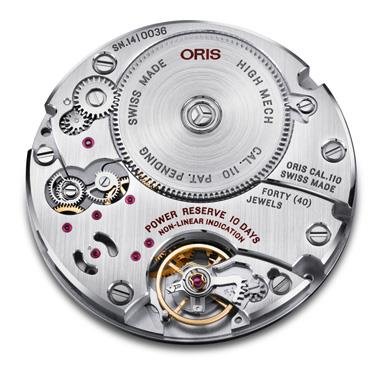
- CALIBRE ORIS 110
Oris had been thinking seriously about recovering its industrial autonomy since the early 2000s. But the plan really came together in 2011, when the decision was taken to relaunch production of a proprietary mechanical movement. The spec sheet drawn up was taken straight from the company’s history books: a manually-wound movement designed specifically for mass-production, a modest 190 components, a power reserve of 10 days achieved with a single large barrel, a nonlinear power reserve indicator (patented: the hand accelerates as the barrel empties), a clean architecture and design paying tribute to its 100% Swiss industrial origins, all at a ‘democratic’ price. The result was the Calibre 110, presented in 2014, the year of the company’s 110th anniversary.
“There were several reasons for this decision,” explains Rolf Studer. “As well as allowing us to reconnect with our industrial heritage as a movement manufacturer, we wanted to offer our clients a movement of our own construction. A movement which, while demonstrating our abilities, remains in our typically affordable price range. It is nevertheless at the top end, coming in at around CHF 5,000. [The average price of an Oris watch is CHF 2,500.] This base movement was designed from the outset to be a springboard for the development of new collections, expanding our range and offering a number of price points. Initial reactions from our retailers and customers were surprising and reassuring. The first anniversary series, limited to 110 units in gold, flew off the shelves, even though its price was exceptionally high for us at CHF 14,500. But what quickly became clear was that people were starting to look at us differently. Retailers are more open to our proposals, and our patient democratic strategy, ‘Real watches for real people’, seems to be coming into its own.”
THE ARTELIER CALIBRE 111
-
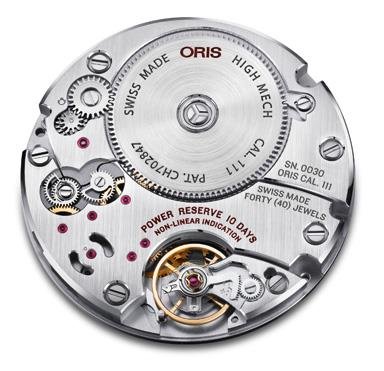
- CALIBRE ORIS 111
Having been put to the test with the Calibre 110, the technology used in the first special series was ready to be incorporated into the brand’s current collections. The Calibre 111 that followed in 2015 had the same strongly structured architecture and the same technical characteristics, including the exceptional 10-day power reserve and non-linear power reserve indicator, the same combination of hand crafted finishes – the bridges are hand-polished and hand-chamfered – and industrial techniques that underline the eminently functional nature of the watch. Where the Calibre 111 differs is in the addition of a third complication in the form of a large date – a combination that is still unique in watchmaking.
Oris, which designed and developed this new movement entirely in-house, is certainly not yet equipped to produce every component internally. But it’s only a matter of time. The parts are manufactured with the help of a number of highly skilled partners along the Jurassic Arc. All of the checking, mounting and assembly, however, is done by Oris.
For this important, perhaps crucial, launch, Oris presented the Calibre 111 in a 43 mm round case with sleek, classical lines, in steel (CHF 5,300) and rose gold (CHF 14,500). Eminently legible, graphically balanced and harmonious, with a domed sapphire crystal front and back and a screwed case back, the Calibre 111 collection comes with a choice of opaline silver-gold, maroon, sunray black-gold or silver-grey dial on a crocodile leather strap.
-
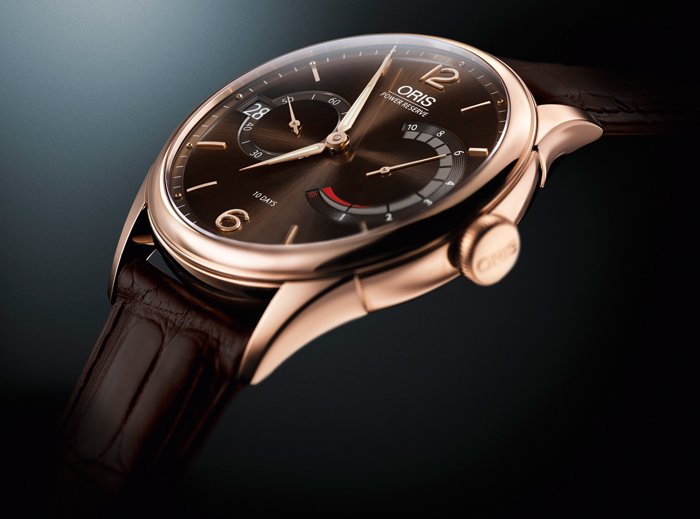
- CALIBRE ORIS 111
Dimensions Ø 34 mm, 15’’’. Functions: Central hour and minute hand, small seconds at 9 o’clock, non-linear power reserve indication at 3 o’clock, date aperture, date corrector, fine timing device and stop-second. Winding: Hand wound. Power reserve: 240 hours.
NEW HEIGHTS: THE ARTELIER CALIBRE 112
With the new in-house family thoroughly put through its paces and fully incorporated into its collections, this year Oris was able to move to the third phase of its programme: the Artelier Calibre 112. Oris’s motto is ‘Real watches for real people’. Given the company’s democratic ambition to offer watches of outstanding quality, with genuinely useful functions, classically elegant looks and superb legibility, it was inevitable that it should, sooner or later, come out with one of the most convenient and practical functions for our internationally nomadic lifestyles: a second time zone located at 12 o’clock, along with a day/night indicator.
The highly regimented architecture of the Calibre 112 perfectly encapsulates Oris’s philosophy, at the crossroads of art and industry. Shaped and machined with superlative precision thanks to the most sophisticated tools, assembled in the Oris workshops, relentlessly checked, finished and decorated both by machine and by hand to achieve the most refined polish, designed to offer incomparable value for money, the Calibre 112 is the engine driving three stylish globe-trotters: in steel with blue-grey dial and a brown crocodile leather strap or steel bracelet; in steel with opaline silver dial and black crocodile strap or steel bracelet; and a bi-colour version with 18K rose gold bezel on a chocolate brown crocodile strap.
With its perfectly legible and elegant face, its scrupulously balanced dial, its functionality, user-friendliness, ergonomic perfection and minimalist aesthetic, the Oris Artelier Calibre 112 Collection marks another step in Oris’s triumphant return to the exacting world of mechanical movement manufacture.
-
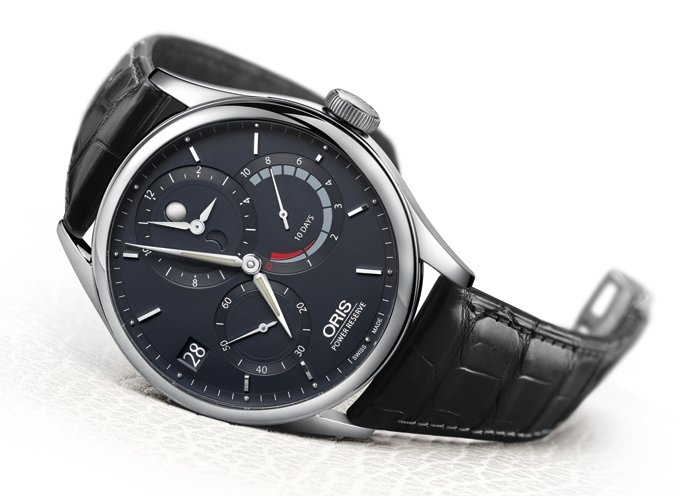
- ORIS ARTELIER CALIBRE 112
![]() WORLD TRAVELLER:The watch’s second time zone appears in a subdial at 12 o’clock and shows the time in full, with dedicated hour and minute hands, while the day/night indication is shown by two apertures in the dial.
WORLD TRAVELLER:The watch’s second time zone appears in a subdial at 12 o’clock and shows the time in full, with dedicated hour and minute hands, while the day/night indication is shown by two apertures in the dial.
![]() ONE BARREL, 10 DAYS: The Calibre 112 uses a single-barrel concept. Power is stored in a mainspring that measures 1.8 metres when stretched out. The calibre has been engineered so that the power is released evenly over the 10-day period.
ONE BARREL, 10 DAYS: The Calibre 112 uses a single-barrel concept. Power is stored in a mainspring that measures 1.8 metres when stretched out. The calibre has been engineered so that the power is released evenly over the 10-day period.
![]() CASE STUDY: The new Oris Calibre 112 collection comes in a choice of two case materials: solid 18-karat rose gold and stainless steel. The 43 mm multi-piece construction case is water-resistant to 3 bar/30 m.
CASE STUDY: The new Oris Calibre 112 collection comes in a choice of two case materials: solid 18-karat rose gold and stainless steel. The 43 mm multi-piece construction case is water-resistant to 3 bar/30 m.
![]() NON-LINEAR POWER RESERVE INDICATOR: The display at 3 o’clock on the dial indicates the amount of power remaining in the barrel from 10 days down to zero. At the top of the scale, the notches representing the days are close together, moving further apart at the bottom. As the power is released the hand moves clockwise around the scale, slowly at first, and then more quickly as the notches become more spread out. This gives the wearer a far clearer indication of how much power is left in the watch as the moment to wind it approaches. Oris has patented this development.
NON-LINEAR POWER RESERVE INDICATOR: The display at 3 o’clock on the dial indicates the amount of power remaining in the barrel from 10 days down to zero. At the top of the scale, the notches representing the days are close together, moving further apart at the bottom. As the power is released the hand moves clockwise around the scale, slowly at first, and then more quickly as the notches become more spread out. This gives the wearer a far clearer indication of how much power is left in the watch as the moment to wind it approaches. Oris has patented this development.
![]() DATE CHANGE: Calibre 112 differs from Calibre 110 in that it has a date window, a useful addition to the watch’s roster of functions.
DATE CHANGE: Calibre 112 differs from Calibre 110 in that it has a date window, a useful addition to the watch’s roster of functions.
![]() IN DETAIL: The Oris Calibre 112 watch is equipped with a sapphire crystal glass covering the dial, a choice of three dials with applied indices and numerals, a sapphire crystal case back and a Louisiana crocodile leather strap. It is delivered in a luxurious wooden box.
IN DETAIL: The Oris Calibre 112 watch is equipped with a sapphire crystal glass covering the dial, a choice of three dials with applied indices and numerals, a sapphire crystal case back and a Louisiana crocodile leather strap. It is delivered in a luxurious wooden box.

